

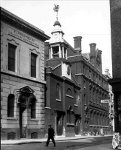
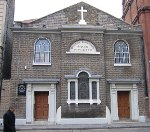 Georgenkirche
(St George's) Alie Street - left in 1920 and today - is the the oldest surviving centre of German
worship, but was the fifth London congregation to be founded. The first
was the Hamburg Church (Hamburger
Lutherische Kirche),
granted a royal charter by Charles II in 1669 (when non-Anglican
churches were still banned), which met in Trinity Lane in the City
until 1874, when it moved to Dalston. The second was Marienkirche,
the church of St Mary-le-Savoy, meeting by William III's permission
from
1694 at his chapel in the Savoy Palace in the Strand (near the site of
the Savoy Hotel), and eventually moving to Bloomsbury as part of a
student centre. The third was the
Reformed congregation of St Paul, whose members were fleeing from religious perecution in the Palatinate, and who also met at the Savoy
from 1696: see below. And in
1700 the Deutsche Hofkapelle,
the German Court Chapel, was founded in St James' Palace by Prince
George of Denmark, the husband of the future Queen Anne. When George I,
who spoke little English, came over from Hanover in 1714, he installed
his court preacher as incumbent, and this continued with George II.
Thus it served mainly the royal household; it was subject to the Bishop
of London and used parts of the Book of Common Prayer in German. This
odd tradition continued until the death of Queen Victoria in 1901, when
a successor congregation was established in South Kensington.
Georgenkirche
(St George's) Alie Street - left in 1920 and today - is the the oldest surviving centre of German
worship, but was the fifth London congregation to be founded. The first
was the Hamburg Church (Hamburger
Lutherische Kirche),
granted a royal charter by Charles II in 1669 (when non-Anglican
churches were still banned), which met in Trinity Lane in the City
until 1874, when it moved to Dalston. The second was Marienkirche,
the church of St Mary-le-Savoy, meeting by William III's permission
from
1694 at his chapel in the Savoy Palace in the Strand (near the site of
the Savoy Hotel), and eventually moving to Bloomsbury as part of a
student centre. The third was the
Reformed congregation of St Paul, whose members were fleeing from religious perecution in the Palatinate, and who also met at the Savoy
from 1696: see below. And in
1700 the Deutsche Hofkapelle,
the German Court Chapel, was founded in St James' Palace by Prince
George of Denmark, the husband of the future Queen Anne. When George I,
who spoke little English, came over from Hanover in 1714, he installed
his court preacher as incumbent, and this continued with George II.
Thus it served mainly the royal household; it was subject to the Bishop
of London and used parts of the Book of Common Prayer in German. This
odd tradition continued until the death of Queen Victoria in 1901, when
a successor congregation was established in South Kensington. 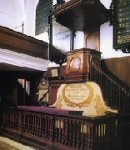
 St
George's was founded in 1762 by Dietrich Beckmann, a wealthy sugar
refiner. His workers formed most of the original congregation, together
with East End merchants from the Hamburg church. Most of the original
interior of the Alie Street church survives, including the ground floor
and gallery box pews and the double-decker pulpit and sounding board.
On the wall above hangs a pre-1801 coat of arms of King George III and
two carved timber Commandment Boards in German. The Royal Arms,
obligatory at the time in Anglican churches and adopted by others as a
mark of loyalty, recall the connection with Queen Victoria's mother,
the Duchess of Kent, who was patron of the schools from 1819 (see
below).
Like the other churches, which do not survive, it was very similar to
Anglican parish churches being built at this time (see P. Guillery St George's German Lutheran Church, Whitechapel in the Georgian Group Journal 14 (2004) pp89-96).
St
George's was founded in 1762 by Dietrich Beckmann, a wealthy sugar
refiner. His workers formed most of the original congregation, together
with East End merchants from the Hamburg church. Most of the original
interior of the Alie Street church survives, including the ground floor
and gallery box pews and the double-decker pulpit and sounding board.
On the wall above hangs a pre-1801 coat of arms of King George III and
two carved timber Commandment Boards in German. The Royal Arms,
obligatory at the time in Anglican churches and adopted by others as a
mark of loyalty, recall the connection with Queen Victoria's mother,
the Duchess of Kent, who was patron of the schools from 1819 (see
below).
Like the other churches, which do not survive, it was very similar to
Anglican parish churches being built at this time (see P. Guillery St George's German Lutheran Church, Whitechapel in the Georgian Group Journal 14 (2004) pp89-96).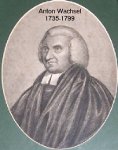 The first pastor
(1763-99) was Gustav Anton Wachsel,
Beckmann's cousin, appointed at the age of 26. He was born in
Halberstadt in East Frisia, on the eastern edge of the Harz
(in former East Germany) around 1735. His father was a partisan
against the
'French invaders' of the area and was shot by them in 1761. At the
conclusion of the Seven
Years War (1756-63), a committee in London
petitioned Waschel's alma mater,
the Georg August University of Göttingen, for a recognition of the help
he had given to escaping refugees:
The first pastor
(1763-99) was Gustav Anton Wachsel,
Beckmann's cousin, appointed at the age of 26. He was born in
Halberstadt in East Frisia, on the eastern edge of the Harz
(in former East Germany) around 1735. His father was a partisan
against the
'French invaders' of the area and was shot by them in 1761. At the
conclusion of the Seven
Years War (1756-63), a committee in London
petitioned Waschel's alma mater,
the Georg August University of Göttingen, for a recognition of the help
he had given to escaping refugees: 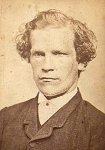 Dr Louis Cappel
was the next pastor. In his time the churchyard and crypt were closed
(1853) and there were no further burials. In 1864 he ministered to
Franz Müller [pictured right], a
tailor who was convicted
of the murder of Mr Briggs on the North London Railway. The trial, and
public execution, aroused great public interest. He denied the charge,
and a 'German Protection Society' was created to plead for
clemency. Cappel was with him on his last day when he went to the
scaffold, at which point he confessed;
reports say that a fuller confession would have followed if
the hangman had not been so anxious
to proceed. See further George H. Knott Trial of Franz Müller (Read Books 2006).
Dr Louis Cappel
was the next pastor. In his time the churchyard and crypt were closed
(1853) and there were no further burials. In 1864 he ministered to
Franz Müller [pictured right], a
tailor who was convicted
of the murder of Mr Briggs on the North London Railway. The trial, and
public execution, aroused great public interest. He denied the charge,
and a 'German Protection Society' was created to plead for
clemency. Cappel was with him on his last day when he went to the
scaffold, at which point he confessed;
reports say that a fuller confession would have followed if
the hangman had not been so anxious
to proceed. See further George H. Knott Trial of Franz Müller (Read Books 2006).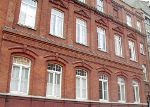
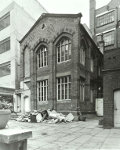 School
numbers swelled in this period, and a new building was
opened in 1877,
designed by E.A. Gruning, the pastor's son-in-law [left - with a rear view of the infant school
behind]. It was financially supported by Wilhelm Heinrich
Göschen, and others such as
George Frederick Vorwerg whose will created a charitable trust (and who
also left an engraved picture of the creation of the world, and £5 for
a mourning ring, to Louis Cappel). It was the only
German school with a nursery, for children over the age of two, to
enable poor mothers to work. Relying on donations from wealthier
members, it survived until 1917. The 1886 religious census of London recorded attendances of 102 (morning) and 83 (evening).
School
numbers swelled in this period, and a new building was
opened in 1877,
designed by E.A. Gruning, the pastor's son-in-law [left - with a rear view of the infant school
behind]. It was financially supported by Wilhelm Heinrich
Göschen, and others such as
George Frederick Vorwerg whose will created a charitable trust (and who
also left an engraved picture of the creation of the world, and £5 for
a mourning ring, to Louis Cappel). It was the only
German school with a nursery, for children over the age of two, to
enable poor mothers to work. Relying on donations from wealthier
members, it survived until 1917. The 1886 religious census of London recorded attendances of 102 (morning) and 83 (evening). 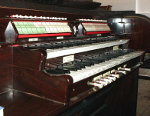
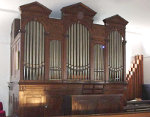 A
new, and characteristically German, organ
was installed the the firm of
Walcker in 1886, using the 1794 case by John England. It was rebuilt in
1937, and restored in 2004, and is used for regular recitals.
A
new, and characteristically German, organ
was installed the the firm of
Walcker in 1886, using the 1794 case by John England. It was rebuilt in
1937, and restored in 2004, and is used for regular recitals.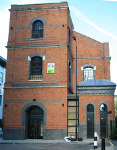
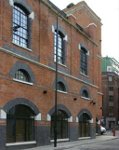
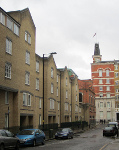
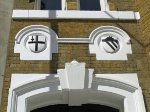
 During Theodor Kübler's
time (1858-75) butchers, from the Würtemberg area, predominated in the
congregation. In 1887, railway works forced another move, when the
bridge over Leman Street into Fenchurch Street was constructed, and on
the Hooper Street site were built a warehouse and Pump House - a
hydraulic pumping station to power the hoists for wagons at the London, Tilbury
& Southend Railway's goods depot on Commercial Road, between
Gower's Walk and Backchurch Lane (see here for more details). Now restored [left], it is a Grade II listed structure; see here for a nearby hydraulic accumulator tower. The congregation moved to Goulston Street, Aldgate. German assimilation proceeded
apace, and the schools were closed in 1896, and sold to the Jewish
Missionary Society.The sugar factories had closed, and their
workers moved away; however, in 1903 there were 175 at the morning and evening services.
During Theodor Kübler's
time (1858-75) butchers, from the Würtemberg area, predominated in the
congregation. In 1887, railway works forced another move, when the
bridge over Leman Street into Fenchurch Street was constructed, and on
the Hooper Street site were built a warehouse and Pump House - a
hydraulic pumping station to power the hoists for wagons at the London, Tilbury
& Southend Railway's goods depot on Commercial Road, between
Gower's Walk and Backchurch Lane (see here for more details). Now restored [left], it is a Grade II listed structure; see here for a nearby hydraulic accumulator tower. The congregation moved to Goulston Street, Aldgate. German assimilation proceeded
apace, and the schools were closed in 1896, and sold to the Jewish
Missionary Society.The sugar factories had closed, and their
workers moved away; however, in 1903 there were 175 at the morning and evening services.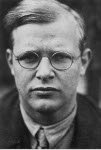 Heinrich Deicke
was pastor from 1905. From 1933-35 the theologian Dietrich Bonhoeffer [right] was
pastor at St Paul's, before he returned to Germany and set up the
Confessing Church seminary, and became involved in the plot to
assassinate Hitler. (He is arguably the greatest theologian and pastor
ever to have ministered within the confines of our parish.) The church
was bombed in 1941, and it merged with St
George's Lutheran Church. The Goulston Street site is now part of London Metropolitan University, and in 2009 a blue plaque
commemorating Bonhoeffer was unveiled there in memory of Bonhoeffer,
who is commemorated in the Anglican calendar as 'Lutheran pastor and
martyr' on 9 April.
Heinrich Deicke
was pastor from 1905. From 1933-35 the theologian Dietrich Bonhoeffer [right] was
pastor at St Paul's, before he returned to Germany and set up the
Confessing Church seminary, and became involved in the plot to
assassinate Hitler. (He is arguably the greatest theologian and pastor
ever to have ministered within the confines of our parish.) The church
was bombed in 1941, and it merged with St
George's Lutheran Church. The Goulston Street site is now part of London Metropolitan University, and in 2009 a blue plaque
commemorating Bonhoeffer was unveiled there in memory of Bonhoeffer,
who is commemorated in the Anglican calendar as 'Lutheran pastor and
martyr' on 9 April. | Gracious God,
the Beyond in the midst of our life, you gave grace to your servant
Dietrich Bonhoeffer to know and to teach the truth as it is in Jesus
Christ, and to bear the cost of following him; Grant that we, strengthened by his teaching and example, may receive your word and embrace its call with an undivided heart; through Jesus Christ our Saviour, who lives and reigns with you and the Holy Spirit, one God, for ever and ever. |
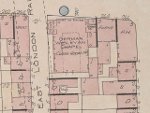
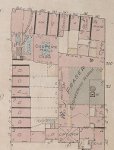 A
congregation was formed at Grosvenor Street Stepney, which then moved
to Coopers' Hall (off the Commercial Road, with its entrance on Berner Street - first right on Goad's 1899 insurance map), before acquiring its own premises at 262 Commercial
Road, more or less over the East London line - second right. A missionary sister took care of German housemaids. Initially the church was served by English preachers who spoke some
German, but from 1874 Paul Schweikher
was its minister; in 1870 there were 130 'full members'. An account
from that year describes a congregation of about 100 of equal numbers of men and women; there was nothing except the language to remind one that it was other than an ordinary English meeting. It has a mix of comfortable tradespeople
with the working classes, to whom the emphasis on
simple gospel preaching, stressing conversion and the after-life,
appealed, and gave a sense of community belonging. The 1886 religious census of London records attendances of 84 (morning) and 97 (evening), with Jakob Urech as minister; J. August Wiesenauer was also a regular preacher. (Back
in Germany, both were members of the German Conference of the Methodist
Episcopal Church of the USA - Urech as superintendent of the Heilbronn
district.) In 1903 the
attendance was 108, and by 1913
there were 220 members, of whom for a time a number were commuting back
to the church once the sugar factories had closed - the reasonably well-off from the
south and west, the poorer from the north and further east (though a
new chapel had been built in Canning Town in 1893). The newer German
Wesleyan congregations in Bloomsbury and Fulham benefitted from the
aspiring classes.
A
congregation was formed at Grosvenor Street Stepney, which then moved
to Coopers' Hall (off the Commercial Road, with its entrance on Berner Street - first right on Goad's 1899 insurance map), before acquiring its own premises at 262 Commercial
Road, more or less over the East London line - second right. A missionary sister took care of German housemaids. Initially the church was served by English preachers who spoke some
German, but from 1874 Paul Schweikher
was its minister; in 1870 there were 130 'full members'. An account
from that year describes a congregation of about 100 of equal numbers of men and women; there was nothing except the language to remind one that it was other than an ordinary English meeting. It has a mix of comfortable tradespeople
with the working classes, to whom the emphasis on
simple gospel preaching, stressing conversion and the after-life,
appealed, and gave a sense of community belonging. The 1886 religious census of London records attendances of 84 (morning) and 97 (evening), with Jakob Urech as minister; J. August Wiesenauer was also a regular preacher. (Back
in Germany, both were members of the German Conference of the Methodist
Episcopal Church of the USA - Urech as superintendent of the Heilbronn
district.) In 1903 the
attendance was 108, and by 1913
there were 220 members, of whom for a time a number were commuting back
to the church once the sugar factories had closed - the reasonably well-off from the
south and west, the poorer from the north and further east (though a
new chapel had been built in Canning Town in 1893). The newer German
Wesleyan congregations in Bloomsbury and Fulham benefitted from the
aspiring classes. | The German Catholics have a special church in Union Street, near St. Mary’s, Whitechapel, which is filled every Sunday morning and evening with a very devout congregation, drawn largely from the working classes. The remarkable feature of this church is the bachelors’ club which is connected with it, or with which it is connected, for the backbone of the mission seems to be the club. The full members are all unmarried men, mostly young. A married man can only be an honorary member; a rule made to avoid all chance of petticoat government. The club, which adjoins the church, is open every evening, but its activities are greatest on Sunday. On that day it opens at 10 a.m., closing at 11 o’clock for Mass; and after the service the members enjoy a glass of Munich beer. Then some dine at the club, but the greater part go home. At 4 o’clock, when the priest gives a short address to the members, the club is again full, and amusements, billiards, &c., fill the time till 7, when the club again closes for the evening service. Afterwards ladies are admitted. The entertainments of the club include lectures, concerts, and dramatic performances. The priest is its president. Perfect order is maintained. It is not a solitary institution, but to be found, we are told, wherever there are many German Catholics. More than a thousand of such clubs exist in various parts of the globe, affiliated in such fashion that to be a member of one is to be welcome at any other, wherever it may be. Amongst the members there is, no doubt, something of that mixture of class which seems to be always practicable under Catholicism. |


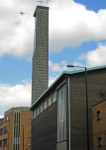 In 1903 the Pallottine Fathers took charge of the
church; in that year, there were 670 attending worship. Slightly damaged by a Zeppelin raid in 1917, the mission
continued, and the church was consecrated by the Archbishop of Cologne
in 1925.
In 1903 the Pallottine Fathers took charge of the
church; in that year, there were 670 attending worship. Slightly damaged by a Zeppelin raid in 1917, the mission
continued, and the church was consecrated by the Archbishop of Cologne
in 1925. 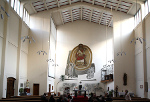 But
it was destroyed in the Blitz in 1940, and worship
continued in temporary accommodation until a fine new church, by
Plaskett Marshall & Partners, was consecrated in 1960. It has a
distinctive campanile, and the Wynfrid Centre provides
residential and conference accommodation. The church has also for many
years been the base for chaplaincy to the Maltese community who first settled in and around Cable Street.
But
it was destroyed in the Blitz in 1940, and worship
continued in temporary accommodation until a fine new church, by
Plaskett Marshall & Partners, was consecrated in 1960. It has a
distinctive campanile, and the Wynfrid Centre provides
residential and conference accommodation. The church has also for many
years been the base for chaplaincy to the Maltese community who first settled in and around Cable Street. | For
Germans and
other European minorities in Britain during the nineteenth and early
twentieth centuries, religion played a less important role [than for
Jews] in the maintenance of ethnicity, allowing cultural activity to
play a larger part. Amongst Germans hundreds of clubs must have existed
during the Victorian and Edwardian years, catering for both the middle
and the working classes and for a wide variety of interests, reflecting
the situation of German communities in other parts of the world.
German clubs, or Vereine, in London were described in an article by
Count Armfelt in 1903, who outlined the activities of both working
class and middles class organisations. Charles Booth's survey of London
at the end of the nineteenth century identified a mixture of working
class and middle class bodies in the East End, including the United
German Club, with 400 members in 1881, the Sonnenscheine and
Niremberg's in Whitechapel, the German Club and a German Bakers' Club
in St George's, and a German Social Club, as well as a German Dramatic
Club in Shoreditch. In addition, clubs frequented by the highest
stratum of German society in Britain existed in cities throughout the
country. In London these included the British Wagner and Goethe
Societies, the German Athenaeum, and the Turnverein, or German
Gymnastic Society ... |
Back to History page